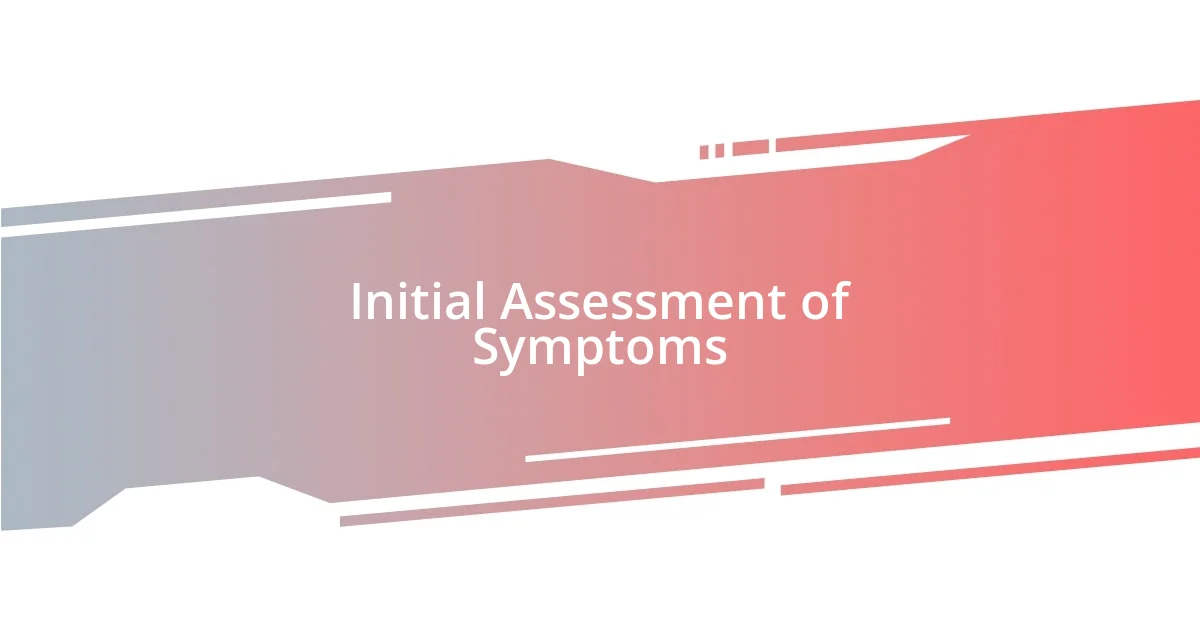Key takeaways:
- CRPS deeply impacts both physical and emotional well-being, affecting patients’ daily lives and relationships, highlighting the need for supportive communication.
- Detailed patient reports and consistent tracking of symptoms are crucial for developing effective treatment plans, allowing for personalized care based on individual experiences.
- Incorporating patient history and fostering an ongoing dialogue enhances the treatment approach, enabling adjustments tailored to each patient’s unique needs and promoting holistic recovery.

Understanding CRPS and Its Impact
Complex Regional Pain Syndrome (CRPS) is a notoriously challenging condition that goes beyond mere physical pain. I remember speaking with a patient who described it as having their nerves set on fire, leaving them feeling helpless and isolated. How can anyone fully grasp the relentless nature of such pain unless they’ve experienced it themselves?
The emotional toll of CRPS is often underestimated. I’ve witnessed patients grappling with feelings of despair and frustration, not just from the pain, but from having their daily lives drastically altered. It raises an important question: how does one cope when every simple task feels like an insurmountable obstacle?
Moreover, CRPS doesn’t just affect the individual; it ripples through families and relationships. I’ve seen how partners often struggle to understand their loved one’s pain, leading to feelings of loneliness on both sides. Isn’t it crucial for us to foster a supportive dialogue that bridges that gap of understanding?

Importance of Detailed Patient Reports
Detailed patient reports are invaluable in understanding CRPS and tailoring effective treatment plans. From my experience, I’ve noticed that the depth and specificity of information in these reports can make all the difference. When a patient shares their journey, including day-to-day fluctuations in their symptoms, it paints a more complete picture of their struggles and helps healthcare providers make informed decisions.
- Captures the unique experiences of each patient.
- Highlights patterns that may not be visible in a one-time consultation.
- Fosters clearer communication between patients and clinicians.
I remember a particular case where a patient meticulously documented their pain triggers over several weeks. Their detailed notes allowed me to identify connections between certain activities and pain flare-ups. This level of engagement not only empowered the patient but also opened doors for more targeted interventions. Having precise information elevates the treatment approach beyond guessing, ultimately enhancing the quality of care.

Initial Assessment of Symptoms
When I start assessing CRPS patients, I focus on their symptom descriptions. Each person’s experience of pain can vary significantly; some may describe it as sharp and stabbing, while others perceive it as dull and aching. Reflecting on my interactions, I recall a patient who used vivid imagery, likening her pain to “electrical shocks coursing through her limbs.” Such descriptions help me understand the pain’s intensity and its impact on their daily activities.
During the initial assessment, I also inquire about any associated symptoms. This might include swelling, changes in skin temperature, or hypersensitivity. One poignant moment stands out to me when a patient shared how simply wearing a sock proved excruciating. It highlighted how CRPS isn’t just about pain; it’s about how even the lightest touch can feel unbearable, making daily life daunting.
I’ve found it essential to encourage patients to reflect on their emotional responses to these symptoms. It’s common for individuals battling CRPS to experience anxiety or depression linked to their pain. I remember asking a patient how their pain affected their mood, and their eyes lit up as they spoke of feeling trapped. Acknowledging these feelings is crucial, as it lays the groundwork for a holistic approach to their treatment.
| Aspect | Patient A | Patient B |
|---|---|---|
| Pain Description | Electrical shocks | Dull ache |
| Associated Symptoms | Swelling, temperature changes | Hypersensitivity |
| Emotional Impact | Feeling trapped | Frustration |

Identifying Key Patterns in Reports
Recognizing patterns in patient reports is where the magic happens. I often notice, over time, recurring themes in how patients describe their symptoms. For instance, one patient consistently reported that her pain spiked around specific times of day—this pattern suggested a need to adjust her medication schedule. Have you ever wondered how subtle details can change treatment strategies?
Digging into these reports reveals interconnectedness among symptoms that might seem unrelated at first. For example, I had a patient who mentioned increased pain levels following emotional stress, which initially felt incidental. But when I reviewed their logs, it became clear that emotional triggers often preceded physical flare-ups. Understanding this connection was crucial in addressing both the mental and physical aspects of their condition.
Additionally, I find it important to pay attention to any changes in patients’ activity levels. In one memorable case, a young man reported feeling worse after returning to exercise too soon. By noting these fluctuations in activity, I could formulate a more balanced approach that encouraged both movement and caution. It’s fascinating how even small adjustments can lead to significant improvements in a patient’s quality of life. What those reports really illustrate is the individual story behind CRPS, unfolding through their eyes.

Utilizing Pain Scales and Metrics
Utilizing pain scales and metrics is an invaluable part of my assessment process for CRPS patients. When I introduce a numerical pain scale, I often see patients visibly engage; they begin to articulate their pain differently. I remember one patient, in particular, who initially rated her pain a “6,” but with a little prodding, she acknowledged it often felt more like an “8” during certain activities. This shift in perception helped steer our conversation toward more targeted strategies for managing her discomfort.
I also find that using scales like the Visual Analog Scale (VAS) provides a tangible way for patients to communicate their experiences. I once worked with a gentleman who struggled to express his pain level verbally, often saying it was “just bad.” When we switched to the VAS, he quickly pointed to the highest point on the scale, allowing us to compare it with his reported symptoms over time. It fascinated me how visual metrics can bridge the gap between subjective experience and objective discussion about treatment options.
Metrics can also highlight day-to-day fluctuations in pain, serving as a tool for both patient and provider. I recall a patient who diligently tracked his pain daily, and when we reviewed the data together, patterns emerged that aligned with his physical activities. He began to notice that certain movements exacerbated his pain, leading us to adjust his rehabilitation protocol accordingly. Isn’t it interesting to see how data can empower patients, transforming their understanding of pain into a collaborative effort for improvement?

Incorporating Patient History Effectively
Incorporating a thorough patient history is pivotal in my analysis of CRPS reports. I find that when I take the time to delve into a patient’s past experiences, especially concerning any psychological or physical traumas, it becomes clear how interconnected these elements are with their current symptoms. For instance, I once learned that a patient had a history of anxiety linked to prior surgeries, which illuminated why certain sensations triggered heightened pain responses. Isn’t it enlightening how understanding a person’s background can shift the focus of your treatment approach?
I make it a point to ask patients about their activities before the onset of symptoms. One particular patient shared that he had been an avid runner until an accident changed everything. Through his account, I grasped not only the physical but also the emotional impact of his lifestyle change. The loss of that beloved activity was palpable in his voice, affecting his mental health as much as his physical condition. By acknowledging these feelings, I could tailor a rehabilitation plan that rekindled his joy in movement while being mindful of his limitations.
Additionally, I pay attention to family medical history, as it often reveals underlying genetic predispositions that could inform my analysis. I recall a case where a woman mentioned chronic pain issues running in her family. Discussing this helped us explore whether there were hereditary factors that could complicate her treatment. Isn’t it fascinating how inherited patterns can illuminate the path ahead during our healing journey? Integrating this aspect of patient history enriches my understanding, ultimately leading to more personalized care.

Developing Actionable Treatment Strategies
Crafting actionable treatment strategies for CRPS patients begins with understanding their unique responses to pain and therapy. I often find that each patient responds differently, even to similar interventions. For instance, I had a patient who thrived on structured, predictable routines in her rehabilitation, while another found flexibility essential for managing her pain. Recognizing these individual needs allows me to tailor strategies that truly resonate with each person.
I also advocate for ongoing dialogue between treatment sessions. One time, a patient called me after feeling especially overwhelmed. Their call prompted a quick adjustment to their pain management strategy that made a world of difference. The back-and-forth communication fosters trust and transforms treatment from a rigid protocol into a dynamic partnership. Isn’t it compelling how much richer treatment becomes when patients feel heard and involved in their recovery process?
Moreover, I am a firm believer in integrating complementary therapies into traditional treatment plans. A patient once expressed curiosity about meditation and its potential for pain relief. We decided to incorporate guided meditation into her regimen, and to my delight, she reported significant improvements in her overall sense of well-being. Isn’t it amazing how exploring various modalities together can unlock new pathways to healing? This holistic approach not only supports pain management but also encourages patients to take an active role in their own self-care journey.















